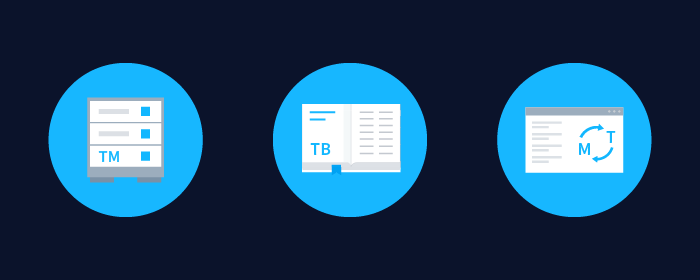
Blog
Machine Translation Report
What is the optimal MT Engine for you? Find out in the latest MT Report by Memsource.

Localization doesn’t have to be a bulky, costly, time-consuming process. Learn how a TMS can help you make the most of it.
Localization doesn’t have to be a bulky, costly, time-consuming process. A translation management system (TMS) enables you to completely automate your translation and localization workflow, leverage different technologies to reduce translation costs, speed up your time to market, and increase the quality of your translations. Get started with these three highly-effective tools.
Translation Memory
Before we get ahead of ourselves, what is translation memory? Translation memory (TM) is a database consisting of original source text and its respective translated segments that can be automatically reused when translating similar or identical content. The beauty of working with TMs is the more you translate, the more this database grows. And as your database grows, you cut down the amount of repeated segments that usually would be re-translated. This reduces the time spent translating, resulting in cost reductions. There is also the added bonus of increasing consistency. When you share your TM with linguists, repeated segments will be the same across the board, increasing the accuracy and quality of translations.
TM is especially effective when source texts use identical or similar phrases, which is often the case with legal, financial, technical, and medical documents. It can increase savings when localizing product manuals, software interfaces, support portals, video games, and product descriptions. It’s also useful for updating documents or making small changes since the majority of the translated text can be reused from the TM.
TM suggests segment matches that range from 101% matches – meaning the content and context of a segment exactly matches the one stored – to fuzzy matches (1-99%) where the content and context differ. Fuzzy matches vary depending on how closely the segment matches the one stored in the translation memory.To maintain quality, consistency, and coherence, it is important for a human translator to check all matches below a 101% match.
Term Bases
What is a term base? A term base (TB) is a list or glossary compiled of multilingual industry or company-specific terminology. At first, this sounds very similar to TM — so how is a term base different from translation memory? A TM is built organically from previously translated segments of text, whereas a TB is a list of terms carefully crafted to ensure accuracy and consistency while translating. This is especially important for highly specialized industries, and hazardous or medical content, where a small mistake could have big consequences. With access to a term base, translators will always use approved terminology in their translations.
When a CAT tool detects a term in the term base, it is displayed in the CAT panel for the translator to insert into the target text. Translators can see which terms should be used, which terms are new, approved, or preferred – and which ones are forbidden and should be avoided completely. Translators no longer have to waste precious time researching industry-specific terms or run the risk of using incorrect terminology. Using a TB helps improve consistency and overall quality of translation projects and can reduce post-editing time.
TM and TB are widely-used strategies to make translation more efficient, but perhaps the most underutilized of all translation technologies is machine translation.
Machine Translation
The third and final key to efficient localization is machine translation (MT). You’re familiar with Google Translate, right? That’s a small glimpse into the world of machine translation. MT is automated translation carried out by a computer rather than by a human. There are different kinds of MT engines that process and produce translations using different approaches, such as rule-based MT, statistical MT, and the rising star – neural MT.
An MT engine can be part built into your TMS or it can be a third-party MT engine integrated via API. This offers flexibility as you can select an MT engine to best suit your translation needs. MT is exceptionally fast as it can translate large amounts of content into multiple languages. This can result in significant time and cost savings. The extent of these savings does, though, depend on the type of content and the quality required. The use of MT can help to ease the pressure on human translators and save them valuable time – allowing them to focus more on the intricacies of translation that a machine cannot manage.
MT has come a long way and is becoming an indispensable part of the translation toolkit, much like TM and TB. Used in combination within a TMS, TM, TB, and MT can result in significant time and cost savings. As MT technology continues to advance, the engines will be producing even higher quality translations which will further increase the efficiency of the translation process. Even more exciting is the presence of features powered by artificial intelligence boosting these TMS features, especially MT.



